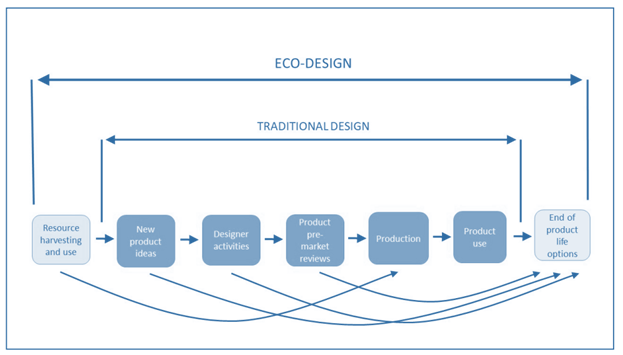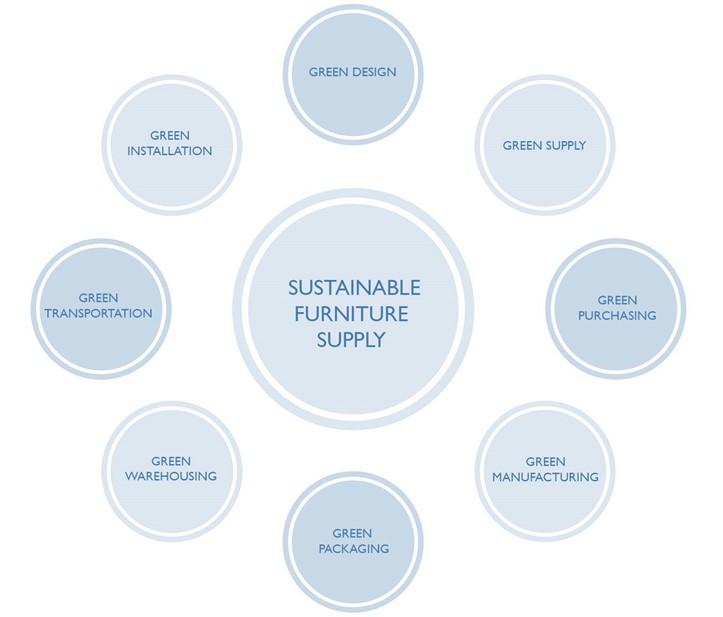Introduction
In light of growing environmental consciousness worldwide and future generations’ increasing influence on the furniture market, furniture companies are increasingly focusing on the environmental impact of their operations, production and selling to the final consumer. A commitment to eco-friendly design and manufacturing principles not only allows companies to do their part to preserve the Earth for generations to come, but it can also be a valuable tool for reducing operational costs, garnering customer loyalty and increasing sales.
Innovation is the foundation of sustainable growth in the business and innovative activity is an important source of competitiveness, economic growth, as well as the image of company. On the other hand, regardless of the amount of investment in innovation, there is no guarantee that this innovation will be accepted by society and customers. Therefore, it is necessary to innovate wisely and with focus. Such an activity requires an enterprise to continuously evaluate its ongoing innovation projects and use that data to decide whether to continue innovation implementation or not.
According to the report of PWC demand for furniture with a better environmental life cycle assessment has been growing for years. Sustainability is a crucial factor for three-quarters of consumers when they are buying furniture. This makes “green” furniture attractive to manufacturers and furniture retailers not just from an ideological perspective, but also from a commercial one.
The objective of this paper was to review and synthesize the literature related to product design in furniture and related products, with an emphasis on design as a source of competitive advantage.
Literature review
Greening is becoming a “trend” and an opportunity for businesses for a variety of reasons, including gaining competitiveness, complying with regulatory requirements, and demonstrating corporate social and environmental responsibility. As a result, many businesses are attempting to include environmental sustainability elements into their product concepts.
Eco-design adds a new dimension to traditional design by evaluating a product’s environmental effect over the course of its life cycle (Dostatni, 2015). It concentrates on enhancing a product’s environmental performance throughout its life cycle, while ignoring other important factors such as performance, utility, aesthetics, and quality. The reduction of material and energy use, the selection of less unfavorable materials, and the promotion of long-life goods are the key environmental aspects that are taken into account in ecodesign (Albk et al, 2020).
According to Mont and Plepys (2008), there is a shortage of understanding about how to shift from materialism to non-materialistic thinking in order to minimize consumption. Consumer demand in developed nations is increasing, making it increasingly difficult to move toward a more sustainable future.
Sustainability, according to Abbas (2017), is defined as “managing actions in a way that preserves the ecological balance.” ‘Practices’ refers to any activity that occurs on a daily basis. Agricultural methods, fishing, manufacturing, energy use, and so on are all examples of business or industrial activities.
Methodology
When studying this topic, the author identifies the following goal, object, subject, and hypothesis of the study.
The purpose of the article is to reveal the main factors influencing implementation of green furniture manufacturing in the furniture retail industry
The Object: IKEA Industry
The Subject: Factors influencing implementation of green furniture manufacturing in the furniture retail industry
Hypothesis:
IKEA Industry’s introduction of sustainable furniture production has been able to reduce its impact on the environment and has influenced the culture of furniture consumption.
Findings
In 2019, the worldwide eco-friendly furniture market was worth USD 35.2 billion. The market is being driven by the increasing use of sustainable materials in furniture manufacture to help the environment. Furthermore, expanding initiatives such as environmentally friendly housing projects in several countries have expanded the market for environmentally friendly furniture among customers. Furthermore, the market is expected to be driven by an inflow of millennial and generation Z customers purchasing eco-friendly furniture throughout the projected period. [5]

Figure 1 S. Eco-friendly furniture market size, by application, 2016-2027 (USD Billion)
With a growing desire to minimize emissions, the popularity of sustainability as a popular trend in house design and remodeling is gaining steam. The growing acceptability of eco-friendly workplaces is fueling the business sector’s expansion.
The primary goal of sustainable production is to reduce a manufacturing system’s environmental effect. Not only that, but it is also necessary to be fiscally responsible and not squander resources, because every investment in manufacturing has consequences, many of which are detrimental for the environment.
Thus, the manufacturing of artifacts should aim to limit the use of natural resources and energy as much as possible, while also adhering to safe environmental standards for the workers in the production plant and for society as a whole.
Models of sustainable manufacturing that are more generic focus around two important points:
- Design
Inventing, creating, and manufacturing low-resource-consumption objects made of materials that do not harm the environment and can be reused.
- Disposal
Implement suitable trash disposal processes for all non-recyclable garbage.
The materials utilized, the location of the suppliers of those materials, the product’s life lifetime, the capacity to reuse/recycle/recover the product or its components, and how the product will be transported and manufactured are all factors that have an influence on the supply chain.
The definition of green design or eco-design encompasses every form of design whose production process minimizes the environmental impact of its products life cycle.
Many enterprises maintain responsible manufacturing processes by obtaining ISO 14001 certification from the International Organization of Standardization in Geneva, which is an international standard for environmental management.
Life-cycle assessment also is important when considering sustainable furniture. Life-cycle assessment takes into account from where materials are sourced, how the item is manufactured and whether it is recyclable or biodegradable at the end of its useful life.
Sustainability in furniture retail
When it comes to the sustainability of furniture, a range of variables play a role. They are mainly due to the contrast between eco-friendly options and traditional and often cheap production, as well as the fact that consumers are watching prices and trends.
- Wood is still the most abundant renewable raw resource. Bamboo, cotton, and novel materials such as algae, on the other hand, are all renewable resources. Another option is furniture created from recycled materials such as PET bottles or old wood fibers.
- Durability: A piece of high-quality furniture with a timeless design may be used for many years and passed down to the next generation. Upcycling also extends the useful life of a piece of furniture.
- Sustainable manufacturing implies social responsibilities as well. This implies that when it comes to buying furniture with a clear conscience, proper working conditions and fair remuneration are critical factors.
- Short transit routes: Using area raw materials and suppliers, as well as keeping manufacture local, reduces a piece of furniture’s carbon impact dramatically.
Responsible sourcing
Furniture is composed of a range of materials, some of which are natural and others which are manufactured. Sustainability, whether found in nature or created in a lab, has a significant influence on an organization’s sourcing strategies. Customers frequently inquire about the origins of products and base purchase decisions on a company’s environmental record.
Many pieces of furniture are made of wood, yet it is one of the most challenging materials to acquire responsibly. Manufacturers must conduct extensive study to identify which types of wood are the most environmentally friendly, and then assess whether they can produce durable furniture with them. This necessitates meeting with a variety of vendors and putting the product through its paces.
Fabric source has also altered dramatically, especially for synthetically produced textiles. Companies must be conscious of their pollution levels and ensure that they are employing eco-friendly chemicals that are at least based on natural sources because the creation of synthetic fabric utilizes so many chemicals. As a result, several furniture producers are switching to materials that may be created from soybeans, feathers, cotton, and wool.
Sustainable production
The attention moves to production after sustainable materials have been found. As previously said, many textiles and mixes necessitate the usage of a lot of chemicals, which might result in toxic waste and pollution. [6] Furniture manufacturers should concentrate on reducing their environmental effect and switching to green production as soon as possible.
In addition to eliminating abrasive chemicals and toxic materials, furniture producers frequently emphasize the use of recycled materials. Recycled alloys may be utilized in any component that requires metal, and fabric adhesives are now typically water-based rather than chemically manufactured. Even minor components like nuts and bolts can be made from recycled materials. When it comes to sustainable production, every little bit helps.
Efficient production
One of every organization’s main aims is to get the most out of the materials it has and to produce goods in the most efficient manner feasible. This entails reducing trash and consuming as little energy as possible in order to save money while staying environmentally conscious.
Reusing extra materials from furniture pieces that had fabric, wood, or other product remaining is one approach to do it. Although the notion of recycling materials may seem obvious, many businesses have failed to do so in the past. Fortunately, many furniture manufacturers are putting a heavy emphasis on this procedure these days, and it is helping both their brand and their bottom line.
Using gear and software that can precisely plan, position, and cut the exact quantity of material needed is a great method to guarantee that a firm is operating effectively and without waste. Gerber Technology, for example, has the technology and knowledge to assist any furniture firm in upholstering their goods using sustainable materials while reducing waste.
Product design
The materials utilized, the location of the suppliers of those materials, the product’s life lifetime, the capacity to reuse and recycle the product or its components, and basically giving the second life, and how the product will be transported and manufactured are all factors that have an influence on the supply chain. Figure below depicts a hypothetical model of the typical furniture design process, as well as the steps introduced when eco-design is included. With eco-design, product decisions are made with the product’s end-of-life in mind, as well as the resources required to create new items. Designers have a tremendous amount of power over how goods affect the environment and society. The European Commission supports the importance of the early phases of product development, stating that the design stage determines more than 80% of a product’s environmental effect.[4]

Figure 2. Comparison of Eco-design and traditional design
Figure 2 depicts a hypothetical model of the typical furniture design process, as well as the steps introduced when eco-design is included. With eco-design, product decisions are made with the product’s end-of-life in mind, as well as the resources required to create new items.
Reduce the impact on the environment and assist consumers in finding healthier goods and design services. Furniture industry transformation approach aims to raise awareness of environmentally friendly furniture and encourage the development of more sustainable alternatives.
A design brand might seek an audit of its manufacturing methods, raw materials utilized, and the degree of impacted waste created from certain organizations to demonstrate its efforts and investments in environmental responsibility, and earn, if warranted, an ad hoc certification.
Among the most important certifications, in the national and international panorama, in the field of eco-sustainability, we can highlight:
- The Made Green Certification
- The FSC Certification
- The OEKO-TEX Certification
- The OK Biobased Certification
- The CARB Certification

Figure 3. Sustainable furniture supply elements
The diagram above shows the components of sustainable furniture supply.
Showing that at different stages of a commodity’s life there are elements worthy of close attention from the side of sustainability and improvement.
IKEA Industry green manufacturing implementation
Multinational corporations have been particularly active in supporting the forest certification agenda in Russia since the outset. Apart from making sponsorship payments, certain global firms, such as IKEA, sit on the FSC Coordination Council as members of the Economic Chamber.
Due to the strict standards imposed on them in the external markets, Russian timber exporters display a higher level of dedication to FSC certification. Promotion of the FSC certification provides a clear economic case for IKEA, the world’s biggest furniture store, because more than two-thirds* of the firm’s goods are manufactured from wood-based components, and the company is one of the world’s greatest users of timber (about 1 percent of global consumption). Russia is a significant market for IKEA, since it supplies around 7% of the wood used in the company’s products. [10] IKEA has established a global aim of becoming “forest positive” by 2020, meaning that all of the company’s wood is supplied in accordance with its forestry guidelines. However, in countries where the dangers of illicit timber are considerable, such as Russia, a deadline of September 1, 2016 has been set to achieve 100% FSC-certified sourcing.
Currently, IKEA products are supplied by more than 20 local suppliers, including four company-owned factories based in Russia. Since September 1, 2016, all IKEA suppliers have been forced to utilize 100% FSC or FSC Mix Credit certified wood. As of January 1, 2016, 55 percent of all Russian vendors’ products come with FSC certification. As a result, the firm encourages suppliers to purchase raw wood products from sustainably managed forests throughout its entire supply chain, promoting improved forest management throughout the whole supply chain. [10]
IKEA provides free FSC consultation services to suppliers and important sub-suppliers. In addition, through its two flagship collaborations with the FSC and the WWF Forest Programme, the firm promotes the growth of FSC optional certification in Russia, Ukraine, and Belarus. IKEA has been working to enhance the supply of wood from sustainably managed forests for many years, and the firm is a founder member of FSC Russia. IKEA’s product design is what customers buy when they visit its shops, and product design should balance the following four aspects to accomplish design and sustainability strategies:
-
Product design: Because everyone is seeking for nice and beautiful designs to add to their homes, product design should be attractive to everybody.
-
Functionality is becoming increasingly important in our daily lives; attractive items must be useful and user-friendly. Consumers will not purchase a product that is difficult to use or useless in their everyday lives.
-
Quality: Another important factor is the product’s quality. Everyone wants the highest quality for the least amount of money.
-
Sustainability: At IKEA, every design must complement the company’s sustainability philosophy
-
Low cost: One of IKEA’s main promises, as well as one of democratic design’s most important duties, is to keep prices low.
These aspects are intertwined with IKEA’s product design. To build a product that fits with IKEA design and sustainability objectives, designers must satisfy all five characteristics.
Discussion and Conclusion
After conducting the research, the author provides conclusions that that in order to implement sustainable furniture production in a large retailer, there are many aspects to consider, such as product design, the production chain, transportation, procurement of raw materials, the quality of the final product allowing for several life cycles and the sale of goods.
All of the above criteria have been successfully implemented by IKEA Industry, which also operates in Russia, showing customers, competitors and other stakeholders the importance of the furniture industry’s impact on sustainable development. Using about 1% of the world’s consumption of wood for its products shows the huge needs of the company in this resource, which, in particular, is extracted in Russia. With this approach to green furniture production, the company raises the bar for sustainability in the local market, encouraging competitors to take action and also use sustainability in the production of furniture products. The company’s attitude helps influence not only competitors in the industry, but also customers, thereby raising the importance of sustainability and the circular economy in everyday life.
Moreover, the company should not stop there. By setting an excellent example, it is worth continuing to be a pioneer and strive for zero waste and full circular economy of retail chain changing the entire furniture industry.
References
- Albaek, J. K., Shahbazi, S., McAloone, T. C., & Pigosso, D.C.A. (2020). Circularity evaluation of alternative concepts during early product design and development. Sustainability, p. 1-25. [online] Available from: https://doi.org/10.3390/su12229353
- Dostatni, E. (2015). Functionality assessment of ecodesign support system. Management and production engineering review. p. 10-15. [online] Available from: https://doi.org/0.1515/mper-2015-0002
- Djunaidi, M.; Sholeh, M.A.A.; Mufiid, N.M.(2018) Analysis of green supply chain management application in Indonesian wood furniture industry. AIP Conf. Proc.
- European Commission. (2018). Sustainable product policy. Retrieved 20 December 2020, [online] Available from: https://ec.europa.eu/jrc/en/research-topic/sustainable-product-policy
- Grandviewresearch (2020) Eco-friendly Furniture Market Size, Share & Trends Analysis Report By Application (Residential, Commercial) [online] Available from: https://www.grandviewresearch.com/industry-analysis/eco-friendly-furniture-market#:~:text=The%20global%20eco%2Dfriendly%20furniture%20market%20size%20was%20estimated%20at,USD%2036.90%20billion%20in%202020.
- Forcellini, F.A.(2015) Green supply chain management and business process management: A union for sustainable process in a furniture factory. p. 1–13.
- Mont, O., & Plepys, A. (2008). Sustainable consumption progress: should we be proud or alarmed? Journal of Cleaner Production, 531-537. [online] Available from: https://doi.org/10.1016/j.jclepro.2007.01.009
- Olkowicz, M., & Grzegorzewska, E. (2014). Eco-design as a strategic way to competitiveness in global markets for furniture family-owned MSMEs. Journal of Intercultural Management, 203–214. [online] Available from: https://doi.org/10.2478/joim-2014-0046.
- Ratnasingam, J., Wagner, K. (2009). Green manufacturing practices among wooden furniture manufacturers in Malaysia. European Journal of Wood and Wood Products, 67, 485–486. [online] Available from: https://doi.org/10.1007/s00107-009-0341-1
- PWC (2018) Closing the loop – the circular economy, what it means and what it can do for you. [online] Available from: https://www.pwc.com/hu/en/kiadvanyok/assets/pdf/Closing-the-loop-the-circular-economy.pdf
- WWF and IKEA (2014) WWF and IKEA Forest Programme. A Partnership for Change. Project report. November 2014, [online] Available from: http://www.wwf.se/ikea/source.php/1620167/141110_wwf_ikea_ responsible_forest_management_2014_final_external.pdf
